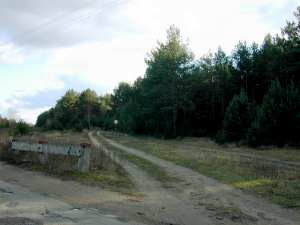



 |
 |
 |
 |
 |
 |
TREBLINKA STAMP
"Generalgouvernement / SS-Sonderkommando Treblinka / Der SS- und Polizeiführer im Distrikt Lublin". |
 |
DEPORTATION FROM SIEDLCE
This photo was taken on 22 August 1942 by the Austrian soldier Hubert Pfoch on his way to the front. Jews being forced to enter the cattle wagons, waiting for them at the Siedlce station. Destination of the train: Treblinka. Hubert Pfoch saw the same train later, standing at Treblinka station. |
 |
TREBLINKA STATION #2
German and Polish railway personal at the station building. Click on the photo for enlargement. |
 |
TREBLINKA STATION #4
View towards the former camp, and Sokolow Podlaski. The photo was taken in November 2004, by Igor Bartosik. Click on the photo for enlargement. |
 |
TURN-OFF NEAR TREBLINKA STATION
Turn-off towards the camp. The former sidetrack has been dismantled. Click on the photo for enlargement. |
 |
THE SLEEPERS
The former railway track through the forest is still visible. Today the railway track is marked by symbolic concrete sleepers. |
 |
EXTERMINATION SITE
These photos are combinations of all available photos. You can see the "Upper Camp" where two or three excavators dug the large burial pits. Click on the photo for enlargement. Excavators |
 |
MASS GRAVE
If Treblinka, the boards were added to the bodies in course of a test burning. Usually the victims were buried in mass graves, later cremated on roasts. Photo: Bundesarchiv No. 183-F0918-0201-011 |
 |
STANGL ON VISIT
Camp commander Franz Stangl visiting Kurt Franz, who replaced him later. The photo shows the entrance of the commander's barrack, one of the two SS barracks or perhaps the barber's barrack. |
 |
STANGL HAVING A TALK
Camp commander Franz Stangl (in the middle) having a talk besides the SS barracks. A small part of the entrance gate is visible on the left. The small birch fences, built by Jewish prisoners, are typical for the SS and Ukrainian areas. A part of these fences is to be seen on the lower right corner of the picture. According to a statement by Münzberger the man with his back turned towards the camera is Willi Mätzig, while the Wehrmacht officer is Stangls friend, the young lieutenant from a non-German unit in Kossow (see also several statements in Sereny's book), with whom Stangl often drank (also on 2 August 1943). Münzberger seemed very sure about this, though he (in another statement) said that Mätzig never wore a gun in Treblinka - and as clearly can be seen, the man one can see from the back is armed, presumably with a revolver. The photo was taken probably in 1943 because Stangl wears the SS peaked cap with the officer cord. Until end of 1942 he wore a police uniform (Schutzpolizei - Schupo). |
 |
SS RIDERS AT TREBLINKA
The photo shows unknown SS men, riding somewhere in the vicinity of Treblinka. Click on the photo for enlargement. |
 |
THE ZOO
Besides the Ukrainian barracks the Jewish forced labourers had to build a zoo. There the perpetrators spent their leisure time sitting on wooden benches and tables. In the background the Ukrainian barracks are visible. |
 |
ZOO STREET
On the left the Ukrainian barracks, in the center the zoo area, on the right the large potatoe mound and perhaps the Goldjuden barrack. In the foreground an inmate at the well. Four inmates are pulling a wooden cart. |
 |
THE BAKERY #1
The new bakery, a brick building, was built where the Zoo Street led into "Kurt Seidel Street". It was not put into operation until the camp was dismantled. |
 |
THE BAKERY #2
Ruin of the new bakery. Photo taken in 1944 by Soviet soldiers after they occupied the camp site. Photo: Courtesy of Thomas Lofvenmark. |
 |
AMMUNITION BUNKER
This ammunition storeroom was located between the two SS barracks. It was built during the first phase of the camp as a concrete cube. In spring 1943 a second storey was added, containing a watertank to supply new showers for the SS staff. During the revolt the SS barracks burned down. This photo was taken by Kurt Franz, after the revolt. |
 |
CHIMNEY IN MALKINIA
The photo on the left was taken in early autumn 1942 by Kurt Franz. SS man Erwin Lambert is working at the chimney in order to destroy it. The bricks were used for building the new gas chambers of Treblinka. The photo on the right shows the site in summer 2002. The trees around the church have grown, new houses have been built but the site where the chimney had been, remained empty. Click on the photo for enlargement. |
 |
THE MONUMENT
The large monument is located near the spot where the former "new gas chambers" were located. It is surrounded by thousands of symbolic tombstones. 2002 Videoclip (3.2 MB) |
 |
A JEWISH GROUP VISITING THE MEMORIAL
In the background the large monument is visible. In the foreground the former ramp is represented by symbolic sleepers and a concrete wall. Line of view: East. |
 |
THE RAMP
From the background the trains entered the camp. The original ramp was located a bit more to the left. The former camp boundaries are shown by large stones (left). Line of view: North. |